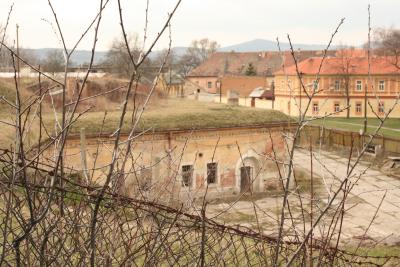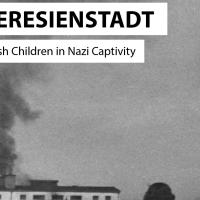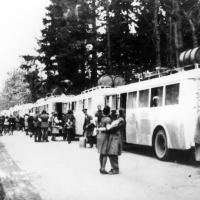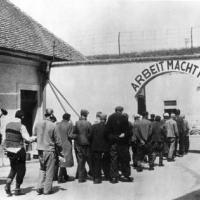The White Busses
After a series of negotioations, the Danish prisoners were released from Theresienstadt in the spring of 1945 and brought to Sweden by the so-called White Busses. A dangerous journey that took the caravan of White Busses through war-torn Europe.
Releases
In January 1944, five Danish prisoners were released from Theresienstadt. Since the beginning of October 1943, when the first deportations took place, the Danish Foreign Ministry had worked to obtain the release of those prisoners who had been deported on ‘wrong’ grounds. According to the Nazis’ own directives to exempt e.g. Jews with a Christian spouse or persons with only one Jewish parent, these people should never have been deported. Although the ministry’s list included about 30 people in this category, only five were released.
The White Buses
In December 1944, the Foreign Ministry received permission to bring sick police officers home from the concentration camp in Buchenwald, Germany. This marked the beginning of a humanitarian operation best known as the Bernadotte Operation or The White Buses. In February 1945, the Swedish Count Folke Bernadotte negotiated with Heinrich Himmler for the release of Scandinavian prisoners from the concentration camps, while the Danish Aid Corps arranged for cars and buses to transport the prisoners. The Swedish and Danish initiative was coordinated, and in March 1945, the operation began. The process of bringing the Scandinavian prisoners back home was carried out until the end of April.
From Theresienstadt to Sweden
On 13 April 1945, the Danish prisoners in Theresienstadt received the message that they were going home. This applied to everyone who had been deported from Denmark, regardless of whether they were Danish citizens. The Danish prisoners were first gathered in the Jäger Barracks, where they had to wait for the buses to arrive in Theresienstadt. A former prisoner described the waiting time:
“Then, all the Danes were gathered in the Jäger Barracks, where we should spend the last days. There was a high fence around the barracks to keep the other prisoners out, while we Danes could go freely in and out. People gathered together outside, partly to ask for the bits of food remaining after we left, and partly to give us the addresses of their families, so we could write and tell them that they were in Theresienstadt.”
After waiting for a day and a half, the prisoners were finally allowed to board the buses that were to drive them to Sweden – Denmark was still occupied. 423 people were released from the camp that day. Not all of them were originally deported from Denmark: A few children were born in the camp; a Danish boy had been deported from Berlin; and a few Czech women had married Danish men in the camp and were therefore allowed to accompany them. One prisoner from Denmark who had been imprisoned in the Small Fortress did not leave with the White Buses. He had to make his own way home after the liberation of Theresienstadt in May 1945.
Going home
On the way to Sweden the buses drove through bombed-out Germany, and sometimes they came very close to the actual bombing attacks. On 17 April, the buses reached the Danish border, where the former prisoners were received with food, cakes and flags. The buses continued to Odense, where the passengers rested for the night. The next morning, the buses drove to Copenhagen, and the group was sailed to Sweden. In Sweden, they were housed in two quarantine camps: Tylösand and Strangnæs. After Denmark’s liberation on 5 May 1945, the former prisoners could finally return to Denmark. Some could immediately move into their homes, which had been cared for by friends, acquaintances or the Social Service in the Municipality of Copenhagen. For others, the homecoming was difficult, since they had lost both their apartments and their belongings while they were in Theresienstadt. They were also emotionally scarred, and many suffered from physical injuries from their stay in Theresienstadt.








